Analysis of Capital Budgeting Techniques in Corporate Finance
VerifiedAdded on 2022/10/01
|8
|2500
|328
Report
AI Summary
This report delves into the realm of corporate financial management, exploring various techniques used for effective decision-making in business operations. It examines four key capital budgeting tools: sensitivity analysis, scenario analysis, break-even analysis, and simulation analysis. Sensitivity analysis assesses the impact of variable changes on NPV and IRR, while scenario analysis evaluates investment outcomes under different conditions. Break-even analysis determines the point where costs equal revenue, aiding in profit maximization. Simulation analysis addresses uncertainty by using trial and error methods, especially with limited data. The report highlights the benefits, steps involved, and potential challenges of each technique, providing a comprehensive overview for financial decision-making in corporate settings. The report emphasizes the importance of these techniques in evaluating investments and achieving financial goals.

1
Corporate financial management
Corporate financial management
Paraphrase This Document
Need a fresh take? Get an instant paraphrase of this document with our AI Paraphraser
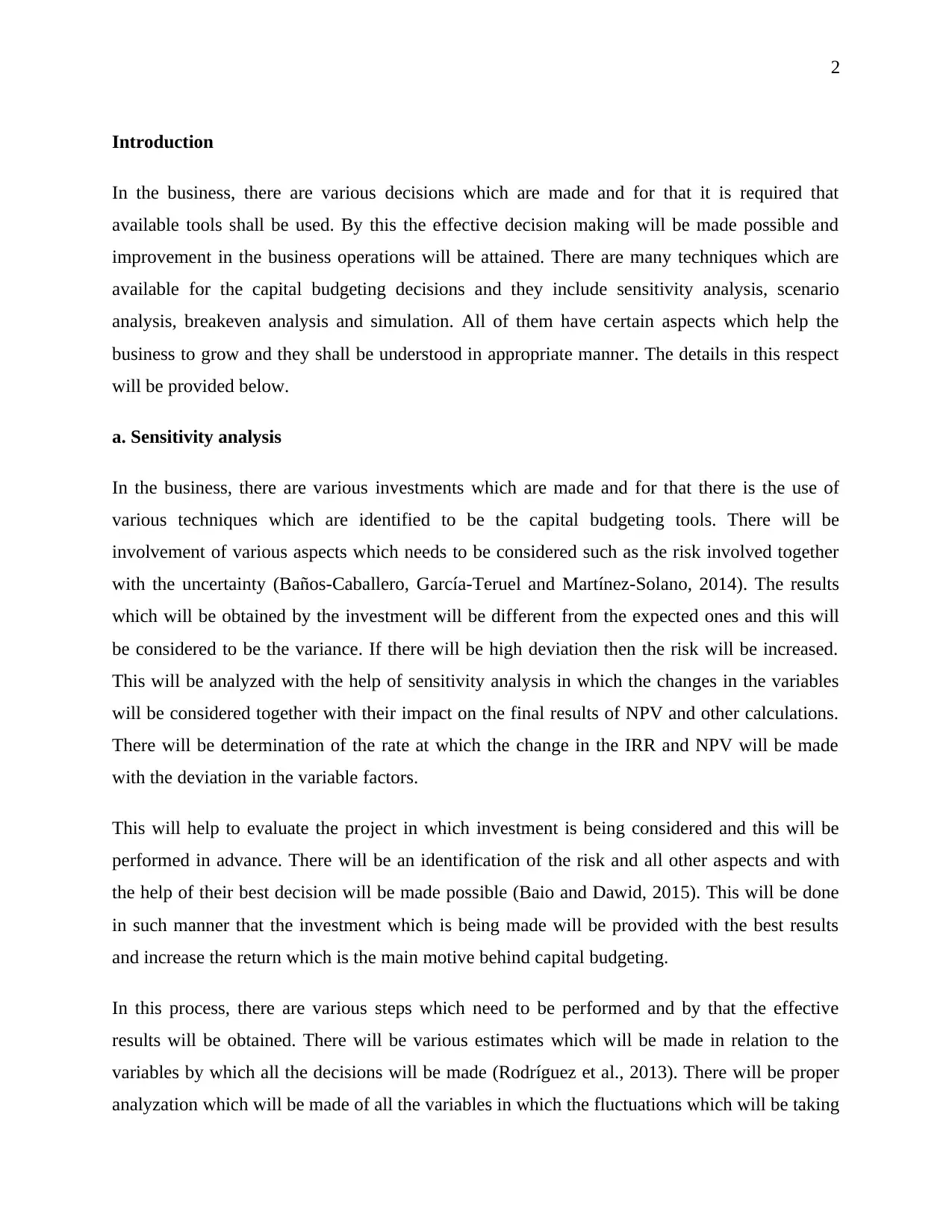
2
Introduction
In the business, there are various decisions which are made and for that it is required that
available tools shall be used. By this the effective decision making will be made possible and
improvement in the business operations will be attained. There are many techniques which are
available for the capital budgeting decisions and they include sensitivity analysis, scenario
analysis, breakeven analysis and simulation. All of them have certain aspects which help the
business to grow and they shall be understood in appropriate manner. The details in this respect
will be provided below.
a. Sensitivity analysis
In the business, there are various investments which are made and for that there is the use of
various techniques which are identified to be the capital budgeting tools. There will be
involvement of various aspects which needs to be considered such as the risk involved together
with the uncertainty (Baños-Caballero, García-Teruel and Martínez-Solano, 2014). The results
which will be obtained by the investment will be different from the expected ones and this will
be considered to be the variance. If there will be high deviation then the risk will be increased.
This will be analyzed with the help of sensitivity analysis in which the changes in the variables
will be considered together with their impact on the final results of NPV and other calculations.
There will be determination of the rate at which the change in the IRR and NPV will be made
with the deviation in the variable factors.
This will help to evaluate the project in which investment is being considered and this will be
performed in advance. There will be an identification of the risk and all other aspects and with
the help of their best decision will be made possible (Baio and Dawid, 2015). This will be done
in such manner that the investment which is being made will be provided with the best results
and increase the return which is the main motive behind capital budgeting.
In this process, there are various steps which need to be performed and by that the effective
results will be obtained. There will be various estimates which will be made in relation to the
variables by which all the decisions will be made (Rodríguez et al., 2013). There will be proper
analyzation which will be made of all the variables in which the fluctuations which will be taking
Introduction
In the business, there are various decisions which are made and for that it is required that
available tools shall be used. By this the effective decision making will be made possible and
improvement in the business operations will be attained. There are many techniques which are
available for the capital budgeting decisions and they include sensitivity analysis, scenario
analysis, breakeven analysis and simulation. All of them have certain aspects which help the
business to grow and they shall be understood in appropriate manner. The details in this respect
will be provided below.
a. Sensitivity analysis
In the business, there are various investments which are made and for that there is the use of
various techniques which are identified to be the capital budgeting tools. There will be
involvement of various aspects which needs to be considered such as the risk involved together
with the uncertainty (Baños-Caballero, García-Teruel and Martínez-Solano, 2014). The results
which will be obtained by the investment will be different from the expected ones and this will
be considered to be the variance. If there will be high deviation then the risk will be increased.
This will be analyzed with the help of sensitivity analysis in which the changes in the variables
will be considered together with their impact on the final results of NPV and other calculations.
There will be determination of the rate at which the change in the IRR and NPV will be made
with the deviation in the variable factors.
This will help to evaluate the project in which investment is being considered and this will be
performed in advance. There will be an identification of the risk and all other aspects and with
the help of their best decision will be made possible (Baio and Dawid, 2015). This will be done
in such manner that the investment which is being made will be provided with the best results
and increase the return which is the main motive behind capital budgeting.
In this process, there are various steps which need to be performed and by that the effective
results will be obtained. There will be various estimates which will be made in relation to the
variables by which all the decisions will be made (Rodríguez et al., 2013). There will be proper
analyzation which will be made of all the variables in which the fluctuations which will be taking
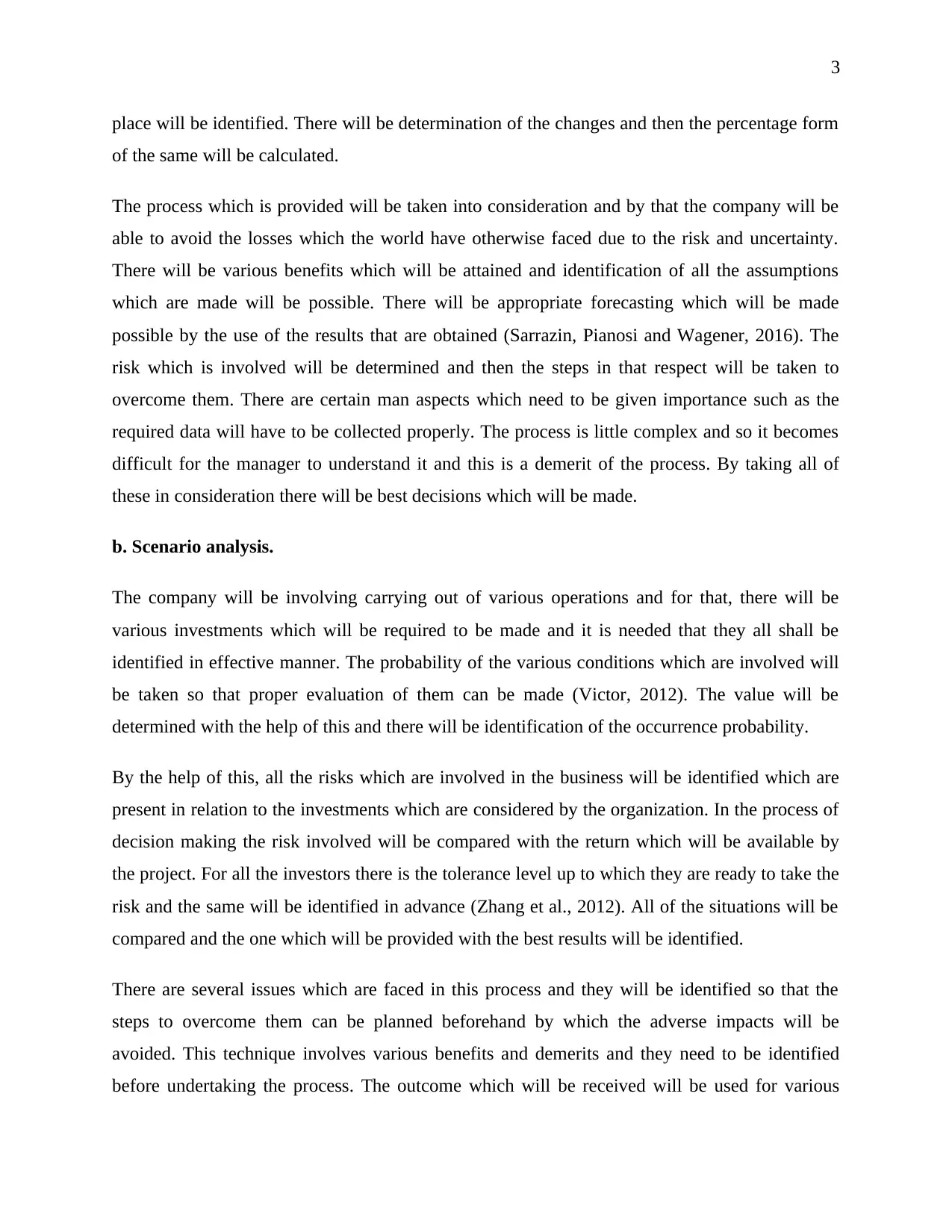
3
place will be identified. There will be determination of the changes and then the percentage form
of the same will be calculated.
The process which is provided will be taken into consideration and by that the company will be
able to avoid the losses which the world have otherwise faced due to the risk and uncertainty.
There will be various benefits which will be attained and identification of all the assumptions
which are made will be possible. There will be appropriate forecasting which will be made
possible by the use of the results that are obtained (Sarrazin, Pianosi and Wagener, 2016). The
risk which is involved will be determined and then the steps in that respect will be taken to
overcome them. There are certain man aspects which need to be given importance such as the
required data will have to be collected properly. The process is little complex and so it becomes
difficult for the manager to understand it and this is a demerit of the process. By taking all of
these in consideration there will be best decisions which will be made.
b. Scenario analysis.
The company will be involving carrying out of various operations and for that, there will be
various investments which will be required to be made and it is needed that they all shall be
identified in effective manner. The probability of the various conditions which are involved will
be taken so that proper evaluation of them can be made (Victor, 2012). The value will be
determined with the help of this and there will be identification of the occurrence probability.
By the help of this, all the risks which are involved in the business will be identified which are
present in relation to the investments which are considered by the organization. In the process of
decision making the risk involved will be compared with the return which will be available by
the project. For all the investors there is the tolerance level up to which they are ready to take the
risk and the same will be identified in advance (Zhang et al., 2012). All of the situations will be
compared and the one which will be provided with the best results will be identified.
There are several issues which are faced in this process and they will be identified so that the
steps to overcome them can be planned beforehand by which the adverse impacts will be
avoided. This technique involves various benefits and demerits and they need to be identified
before undertaking the process. The outcome which will be received will be used for various
place will be identified. There will be determination of the changes and then the percentage form
of the same will be calculated.
The process which is provided will be taken into consideration and by that the company will be
able to avoid the losses which the world have otherwise faced due to the risk and uncertainty.
There will be various benefits which will be attained and identification of all the assumptions
which are made will be possible. There will be appropriate forecasting which will be made
possible by the use of the results that are obtained (Sarrazin, Pianosi and Wagener, 2016). The
risk which is involved will be determined and then the steps in that respect will be taken to
overcome them. There are certain man aspects which need to be given importance such as the
required data will have to be collected properly. The process is little complex and so it becomes
difficult for the manager to understand it and this is a demerit of the process. By taking all of
these in consideration there will be best decisions which will be made.
b. Scenario analysis.
The company will be involving carrying out of various operations and for that, there will be
various investments which will be required to be made and it is needed that they all shall be
identified in effective manner. The probability of the various conditions which are involved will
be taken so that proper evaluation of them can be made (Victor, 2012). The value will be
determined with the help of this and there will be identification of the occurrence probability.
By the help of this, all the risks which are involved in the business will be identified which are
present in relation to the investments which are considered by the organization. In the process of
decision making the risk involved will be compared with the return which will be available by
the project. For all the investors there is the tolerance level up to which they are ready to take the
risk and the same will be identified in advance (Zhang et al., 2012). All of the situations will be
compared and the one which will be provided with the best results will be identified.
There are several issues which are faced in this process and they will be identified so that the
steps to overcome them can be planned beforehand by which the adverse impacts will be
avoided. This technique involves various benefits and demerits and they need to be identified
before undertaking the process. The outcome which will be received will be used for various
⊘ This is a preview!⊘
Do you want full access?
Subscribe today to unlock all pages.

Trusted by 1+ million students worldwide
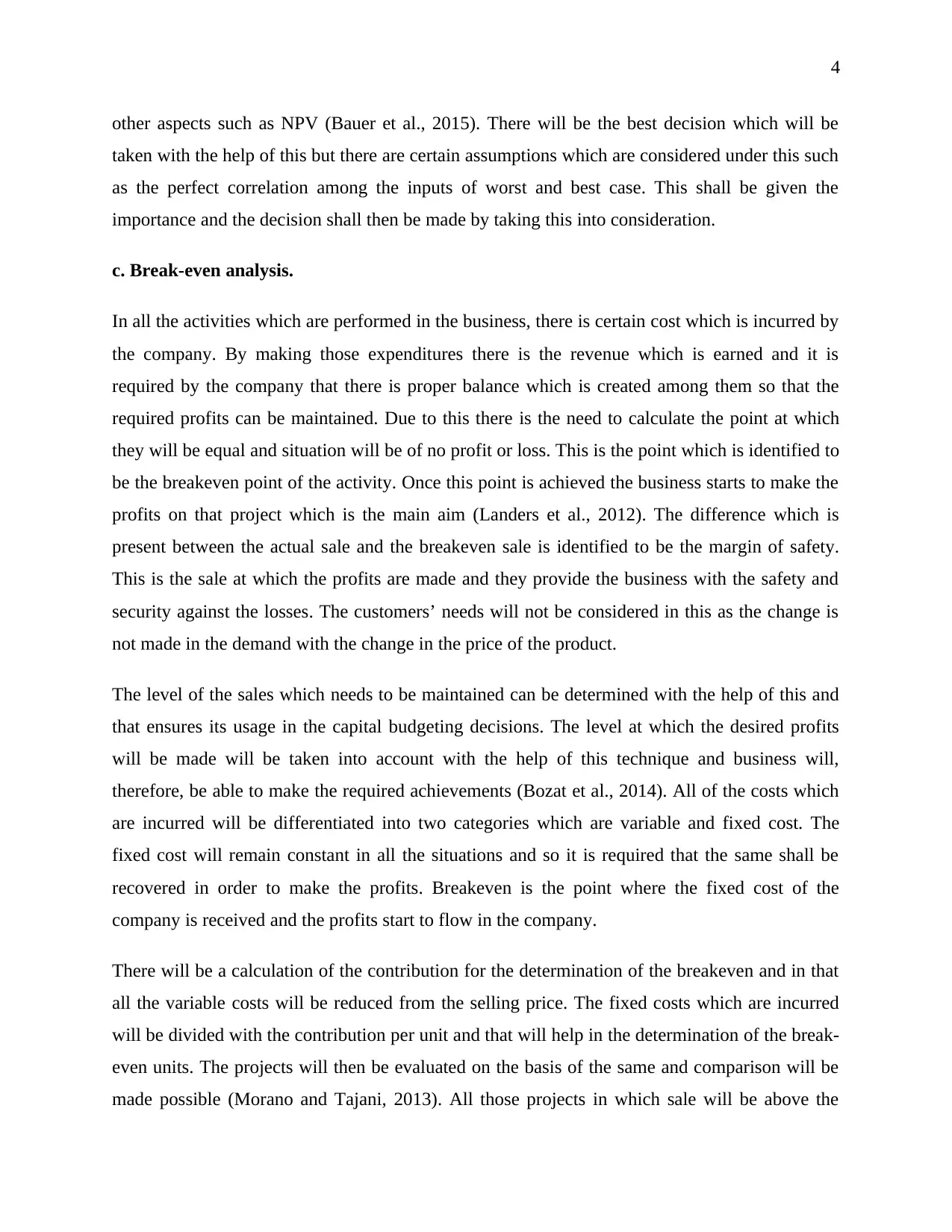
4
other aspects such as NPV (Bauer et al., 2015). There will be the best decision which will be
taken with the help of this but there are certain assumptions which are considered under this such
as the perfect correlation among the inputs of worst and best case. This shall be given the
importance and the decision shall then be made by taking this into consideration.
c. Break-even analysis.
In all the activities which are performed in the business, there is certain cost which is incurred by
the company. By making those expenditures there is the revenue which is earned and it is
required by the company that there is proper balance which is created among them so that the
required profits can be maintained. Due to this there is the need to calculate the point at which
they will be equal and situation will be of no profit or loss. This is the point which is identified to
be the breakeven point of the activity. Once this point is achieved the business starts to make the
profits on that project which is the main aim (Landers et al., 2012). The difference which is
present between the actual sale and the breakeven sale is identified to be the margin of safety.
This is the sale at which the profits are made and they provide the business with the safety and
security against the losses. The customers’ needs will not be considered in this as the change is
not made in the demand with the change in the price of the product.
The level of the sales which needs to be maintained can be determined with the help of this and
that ensures its usage in the capital budgeting decisions. The level at which the desired profits
will be made will be taken into account with the help of this technique and business will,
therefore, be able to make the required achievements (Bozat et al., 2014). All of the costs which
are incurred will be differentiated into two categories which are variable and fixed cost. The
fixed cost will remain constant in all the situations and so it is required that the same shall be
recovered in order to make the profits. Breakeven is the point where the fixed cost of the
company is received and the profits start to flow in the company.
There will be a calculation of the contribution for the determination of the breakeven and in that
all the variable costs will be reduced from the selling price. The fixed costs which are incurred
will be divided with the contribution per unit and that will help in the determination of the break-
even units. The projects will then be evaluated on the basis of the same and comparison will be
made possible (Morano and Tajani, 2013). All those projects in which sale will be above the
other aspects such as NPV (Bauer et al., 2015). There will be the best decision which will be
taken with the help of this but there are certain assumptions which are considered under this such
as the perfect correlation among the inputs of worst and best case. This shall be given the
importance and the decision shall then be made by taking this into consideration.
c. Break-even analysis.
In all the activities which are performed in the business, there is certain cost which is incurred by
the company. By making those expenditures there is the revenue which is earned and it is
required by the company that there is proper balance which is created among them so that the
required profits can be maintained. Due to this there is the need to calculate the point at which
they will be equal and situation will be of no profit or loss. This is the point which is identified to
be the breakeven point of the activity. Once this point is achieved the business starts to make the
profits on that project which is the main aim (Landers et al., 2012). The difference which is
present between the actual sale and the breakeven sale is identified to be the margin of safety.
This is the sale at which the profits are made and they provide the business with the safety and
security against the losses. The customers’ needs will not be considered in this as the change is
not made in the demand with the change in the price of the product.
The level of the sales which needs to be maintained can be determined with the help of this and
that ensures its usage in the capital budgeting decisions. The level at which the desired profits
will be made will be taken into account with the help of this technique and business will,
therefore, be able to make the required achievements (Bozat et al., 2014). All of the costs which
are incurred will be differentiated into two categories which are variable and fixed cost. The
fixed cost will remain constant in all the situations and so it is required that the same shall be
recovered in order to make the profits. Breakeven is the point where the fixed cost of the
company is received and the profits start to flow in the company.
There will be a calculation of the contribution for the determination of the breakeven and in that
all the variable costs will be reduced from the selling price. The fixed costs which are incurred
will be divided with the contribution per unit and that will help in the determination of the break-
even units. The projects will then be evaluated on the basis of the same and comparison will be
made possible (Morano and Tajani, 2013). All those projects in which sale will be above the
Paraphrase This Document
Need a fresh take? Get an instant paraphrase of this document with our AI Paraphraser
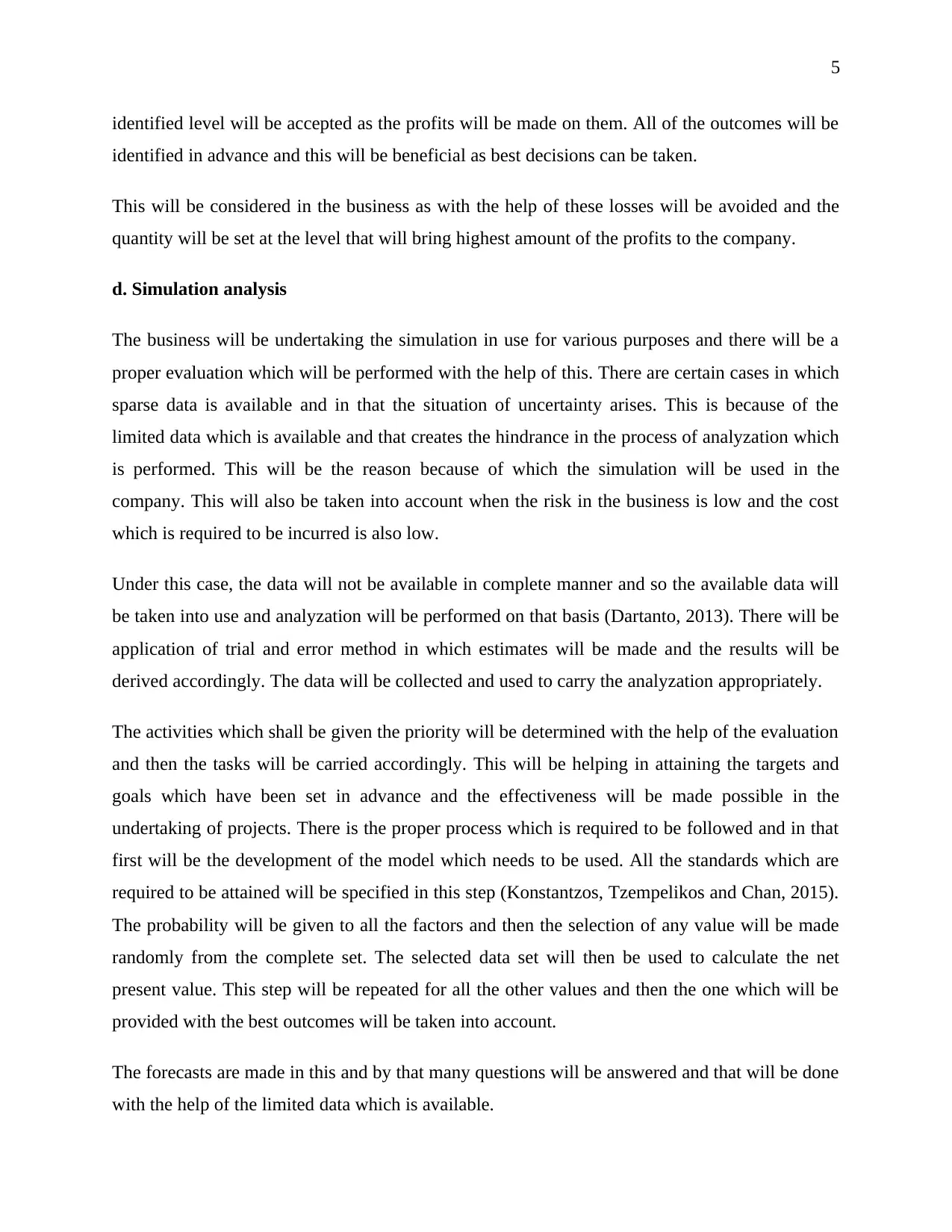
5
identified level will be accepted as the profits will be made on them. All of the outcomes will be
identified in advance and this will be beneficial as best decisions can be taken.
This will be considered in the business as with the help of these losses will be avoided and the
quantity will be set at the level that will bring highest amount of the profits to the company.
d. Simulation analysis
The business will be undertaking the simulation in use for various purposes and there will be a
proper evaluation which will be performed with the help of this. There are certain cases in which
sparse data is available and in that the situation of uncertainty arises. This is because of the
limited data which is available and that creates the hindrance in the process of analyzation which
is performed. This will be the reason because of which the simulation will be used in the
company. This will also be taken into account when the risk in the business is low and the cost
which is required to be incurred is also low.
Under this case, the data will not be available in complete manner and so the available data will
be taken into use and analyzation will be performed on that basis (Dartanto, 2013). There will be
application of trial and error method in which estimates will be made and the results will be
derived accordingly. The data will be collected and used to carry the analyzation appropriately.
The activities which shall be given the priority will be determined with the help of the evaluation
and then the tasks will be carried accordingly. This will be helping in attaining the targets and
goals which have been set in advance and the effectiveness will be made possible in the
undertaking of projects. There is the proper process which is required to be followed and in that
first will be the development of the model which needs to be used. All the standards which are
required to be attained will be specified in this step (Konstantzos, Tzempelikos and Chan, 2015).
The probability will be given to all the factors and then the selection of any value will be made
randomly from the complete set. The selected data set will then be used to calculate the net
present value. This step will be repeated for all the other values and then the one which will be
provided with the best outcomes will be taken into account.
The forecasts are made in this and by that many questions will be answered and that will be done
with the help of the limited data which is available.
identified level will be accepted as the profits will be made on them. All of the outcomes will be
identified in advance and this will be beneficial as best decisions can be taken.
This will be considered in the business as with the help of these losses will be avoided and the
quantity will be set at the level that will bring highest amount of the profits to the company.
d. Simulation analysis
The business will be undertaking the simulation in use for various purposes and there will be a
proper evaluation which will be performed with the help of this. There are certain cases in which
sparse data is available and in that the situation of uncertainty arises. This is because of the
limited data which is available and that creates the hindrance in the process of analyzation which
is performed. This will be the reason because of which the simulation will be used in the
company. This will also be taken into account when the risk in the business is low and the cost
which is required to be incurred is also low.
Under this case, the data will not be available in complete manner and so the available data will
be taken into use and analyzation will be performed on that basis (Dartanto, 2013). There will be
application of trial and error method in which estimates will be made and the results will be
derived accordingly. The data will be collected and used to carry the analyzation appropriately.
The activities which shall be given the priority will be determined with the help of the evaluation
and then the tasks will be carried accordingly. This will be helping in attaining the targets and
goals which have been set in advance and the effectiveness will be made possible in the
undertaking of projects. There is the proper process which is required to be followed and in that
first will be the development of the model which needs to be used. All the standards which are
required to be attained will be specified in this step (Konstantzos, Tzempelikos and Chan, 2015).
The probability will be given to all the factors and then the selection of any value will be made
randomly from the complete set. The selected data set will then be used to calculate the net
present value. This step will be repeated for all the other values and then the one which will be
provided with the best outcomes will be taken into account.
The forecasts are made in this and by that many questions will be answered and that will be done
with the help of the limited data which is available.
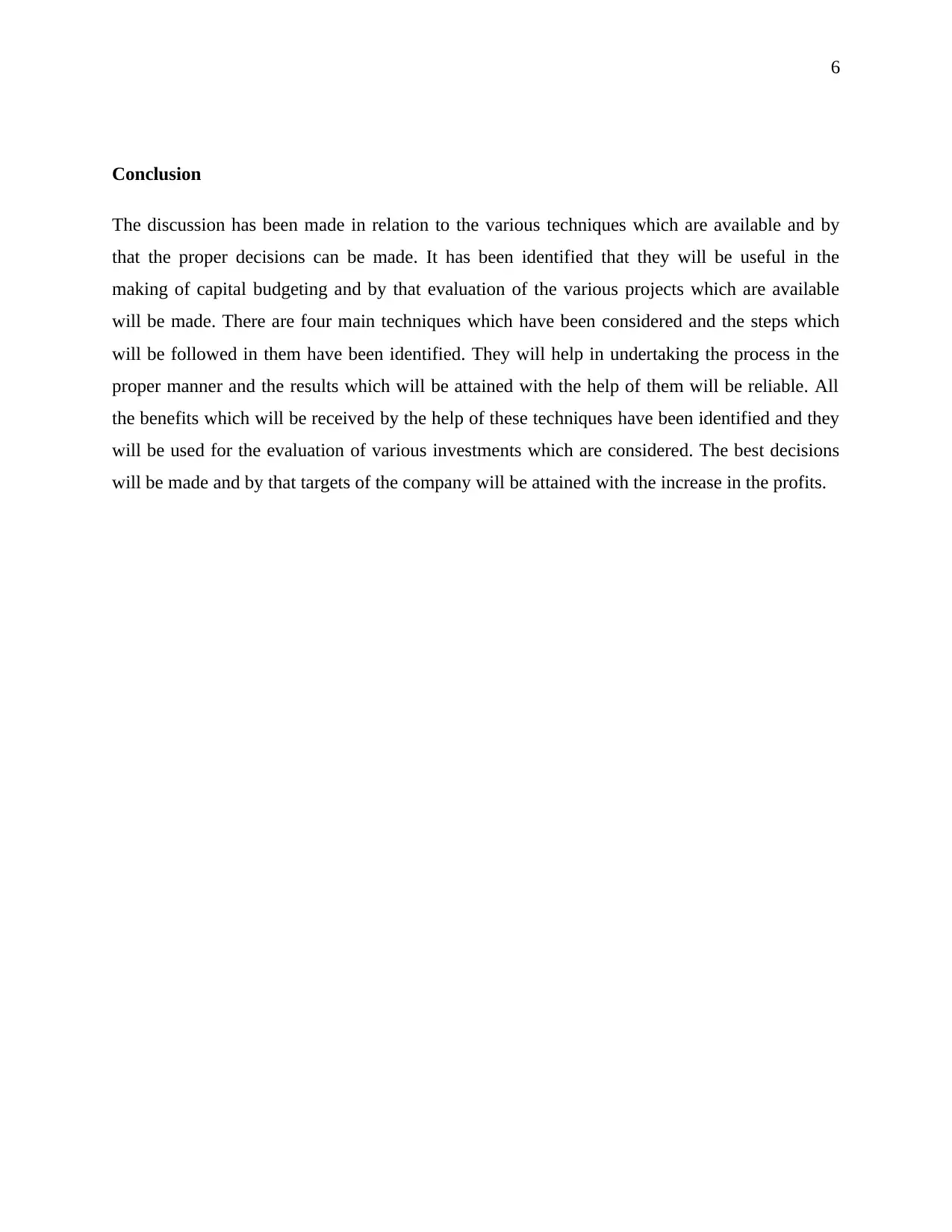
6
Conclusion
The discussion has been made in relation to the various techniques which are available and by
that the proper decisions can be made. It has been identified that they will be useful in the
making of capital budgeting and by that evaluation of the various projects which are available
will be made. There are four main techniques which have been considered and the steps which
will be followed in them have been identified. They will help in undertaking the process in the
proper manner and the results which will be attained with the help of them will be reliable. All
the benefits which will be received by the help of these techniques have been identified and they
will be used for the evaluation of various investments which are considered. The best decisions
will be made and by that targets of the company will be attained with the increase in the profits.
Conclusion
The discussion has been made in relation to the various techniques which are available and by
that the proper decisions can be made. It has been identified that they will be useful in the
making of capital budgeting and by that evaluation of the various projects which are available
will be made. There are four main techniques which have been considered and the steps which
will be followed in them have been identified. They will help in undertaking the process in the
proper manner and the results which will be attained with the help of them will be reliable. All
the benefits which will be received by the help of these techniques have been identified and they
will be used for the evaluation of various investments which are considered. The best decisions
will be made and by that targets of the company will be attained with the increase in the profits.
⊘ This is a preview!⊘
Do you want full access?
Subscribe today to unlock all pages.

Trusted by 1+ million students worldwide
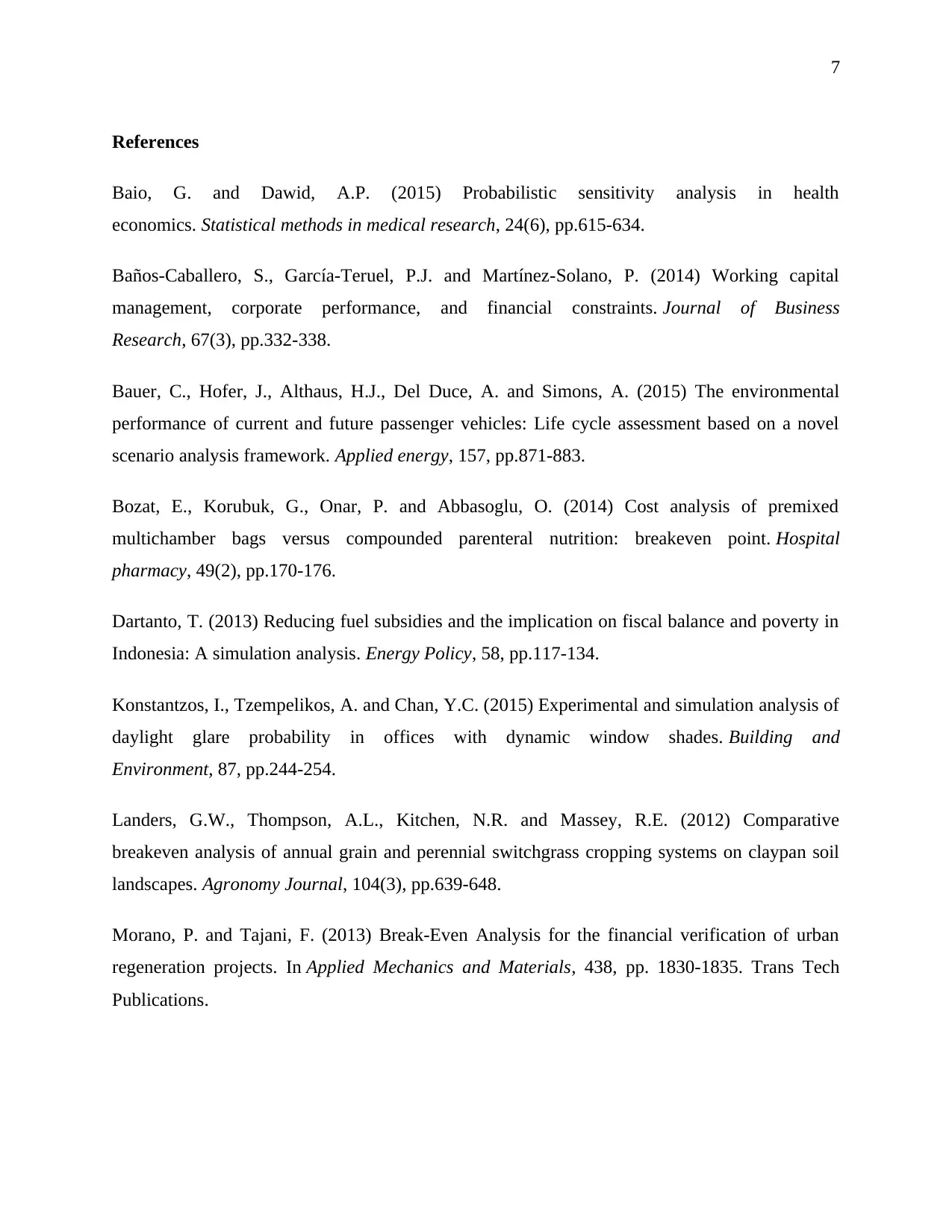
7
References
Baio, G. and Dawid, A.P. (2015) Probabilistic sensitivity analysis in health
economics. Statistical methods in medical research, 24(6), pp.615-634.
Baños-Caballero, S., García-Teruel, P.J. and Martínez-Solano, P. (2014) Working capital
management, corporate performance, and financial constraints. Journal of Business
Research, 67(3), pp.332-338.
Bauer, C., Hofer, J., Althaus, H.J., Del Duce, A. and Simons, A. (2015) The environmental
performance of current and future passenger vehicles: Life cycle assessment based on a novel
scenario analysis framework. Applied energy, 157, pp.871-883.
Bozat, E., Korubuk, G., Onar, P. and Abbasoglu, O. (2014) Cost analysis of premixed
multichamber bags versus compounded parenteral nutrition: breakeven point. Hospital
pharmacy, 49(2), pp.170-176.
Dartanto, T. (2013) Reducing fuel subsidies and the implication on fiscal balance and poverty in
Indonesia: A simulation analysis. Energy Policy, 58, pp.117-134.
Konstantzos, I., Tzempelikos, A. and Chan, Y.C. (2015) Experimental and simulation analysis of
daylight glare probability in offices with dynamic window shades. Building and
Environment, 87, pp.244-254.
Landers, G.W., Thompson, A.L., Kitchen, N.R. and Massey, R.E. (2012) Comparative
breakeven analysis of annual grain and perennial switchgrass cropping systems on claypan soil
landscapes. Agronomy Journal, 104(3), pp.639-648.
Morano, P. and Tajani, F. (2013) Break-Even Analysis for the financial verification of urban
regeneration projects. In Applied Mechanics and Materials, 438, pp. 1830-1835. Trans Tech
Publications.
References
Baio, G. and Dawid, A.P. (2015) Probabilistic sensitivity analysis in health
economics. Statistical methods in medical research, 24(6), pp.615-634.
Baños-Caballero, S., García-Teruel, P.J. and Martínez-Solano, P. (2014) Working capital
management, corporate performance, and financial constraints. Journal of Business
Research, 67(3), pp.332-338.
Bauer, C., Hofer, J., Althaus, H.J., Del Duce, A. and Simons, A. (2015) The environmental
performance of current and future passenger vehicles: Life cycle assessment based on a novel
scenario analysis framework. Applied energy, 157, pp.871-883.
Bozat, E., Korubuk, G., Onar, P. and Abbasoglu, O. (2014) Cost analysis of premixed
multichamber bags versus compounded parenteral nutrition: breakeven point. Hospital
pharmacy, 49(2), pp.170-176.
Dartanto, T. (2013) Reducing fuel subsidies and the implication on fiscal balance and poverty in
Indonesia: A simulation analysis. Energy Policy, 58, pp.117-134.
Konstantzos, I., Tzempelikos, A. and Chan, Y.C. (2015) Experimental and simulation analysis of
daylight glare probability in offices with dynamic window shades. Building and
Environment, 87, pp.244-254.
Landers, G.W., Thompson, A.L., Kitchen, N.R. and Massey, R.E. (2012) Comparative
breakeven analysis of annual grain and perennial switchgrass cropping systems on claypan soil
landscapes. Agronomy Journal, 104(3), pp.639-648.
Morano, P. and Tajani, F. (2013) Break-Even Analysis for the financial verification of urban
regeneration projects. In Applied Mechanics and Materials, 438, pp. 1830-1835. Trans Tech
Publications.
Paraphrase This Document
Need a fresh take? Get an instant paraphrase of this document with our AI Paraphraser
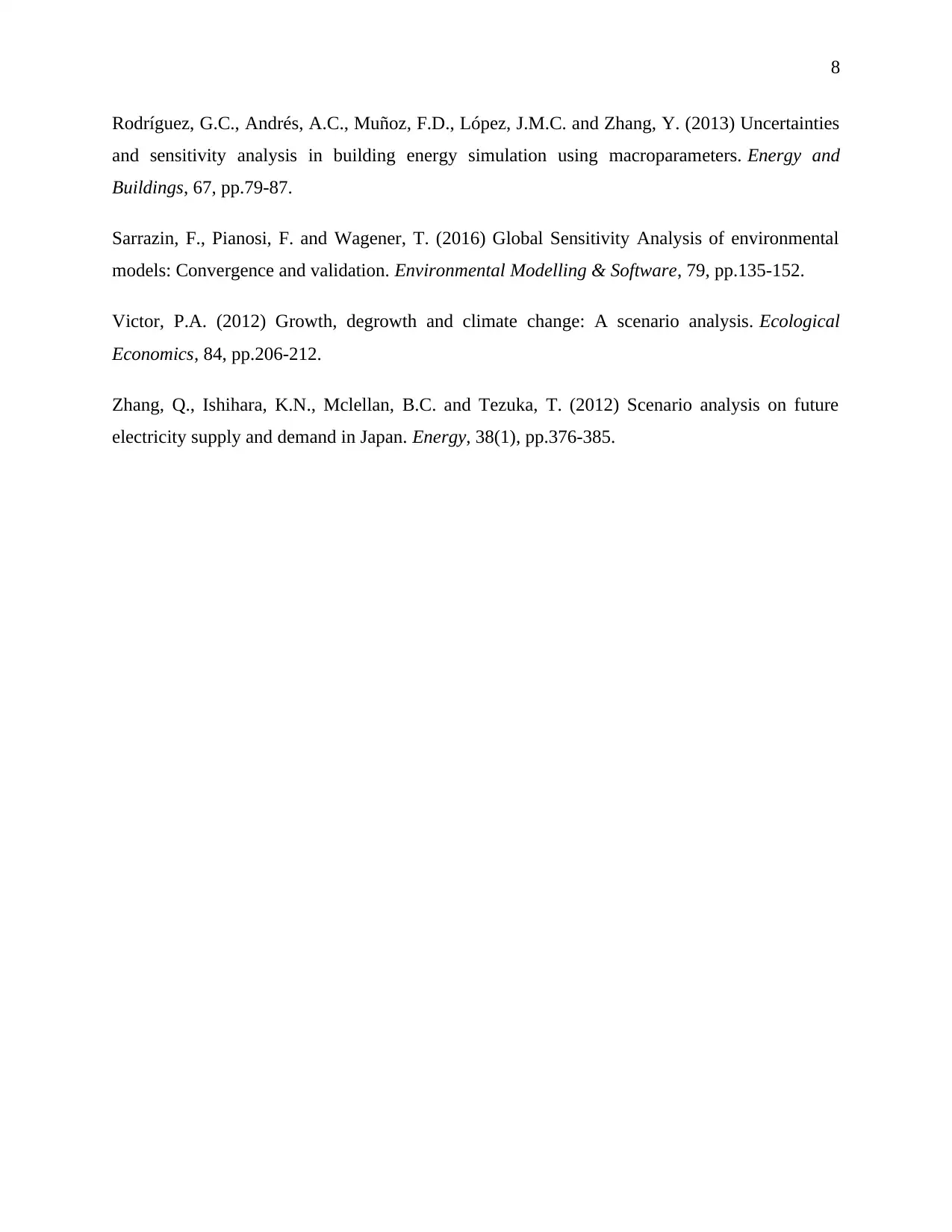
8
Rodríguez, G.C., Andrés, A.C., Muñoz, F.D., López, J.M.C. and Zhang, Y. (2013) Uncertainties
and sensitivity analysis in building energy simulation using macroparameters. Energy and
Buildings, 67, pp.79-87.
Sarrazin, F., Pianosi, F. and Wagener, T. (2016) Global Sensitivity Analysis of environmental
models: Convergence and validation. Environmental Modelling & Software, 79, pp.135-152.
Victor, P.A. (2012) Growth, degrowth and climate change: A scenario analysis. Ecological
Economics, 84, pp.206-212.
Zhang, Q., Ishihara, K.N., Mclellan, B.C. and Tezuka, T. (2012) Scenario analysis on future
electricity supply and demand in Japan. Energy, 38(1), pp.376-385.
Rodríguez, G.C., Andrés, A.C., Muñoz, F.D., López, J.M.C. and Zhang, Y. (2013) Uncertainties
and sensitivity analysis in building energy simulation using macroparameters. Energy and
Buildings, 67, pp.79-87.
Sarrazin, F., Pianosi, F. and Wagener, T. (2016) Global Sensitivity Analysis of environmental
models: Convergence and validation. Environmental Modelling & Software, 79, pp.135-152.
Victor, P.A. (2012) Growth, degrowth and climate change: A scenario analysis. Ecological
Economics, 84, pp.206-212.
Zhang, Q., Ishihara, K.N., Mclellan, B.C. and Tezuka, T. (2012) Scenario analysis on future
electricity supply and demand in Japan. Energy, 38(1), pp.376-385.
1 out of 8
Related Documents
Your All-in-One AI-Powered Toolkit for Academic Success.
+13062052269
info@desklib.com
Available 24*7 on WhatsApp / Email
![[object Object]](/_next/static/media/star-bottom.7253800d.svg)
Unlock your academic potential
Copyright © 2020–2025 A2Z Services. All Rights Reserved. Developed and managed by ZUCOL.





